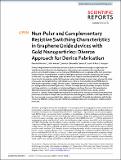Non-polar and complementary resistive switching characteristics in graphene oxide devices with gold nanoparticles : diverse approach for device fabrication
Date
22/10/2019Metadata
Show full item recordAbstract
Downscaling limitations and limited write/erase cycles in conventional charge-storage based non-volatile memories stimulate the development of emerging memory devices having enhanced performance. Resistive random-access memory (RRAM) devices are recognized as the next-generation memory devices for employment in artificial intelligence and neuromorphic computing, due to their smallest cell size, high write/erase speed and endurance. Unipolar and bipolar resistive switching characteristics in graphene oxide (GO) have been extensively studied in recent years, whereas the study of non-polar and complementary switching is scarce. Here we fabricated GO-based RRAM devices with gold nanoparticles (Au Nps). Diverse types of switching behavior are observed by changing the processing methods and device geometry. Tri-layer GO-based devices illustrated non-polar resistive switching, which is a combination of unipolar and bipolar switching. Five-layer GO-based devices depicted complementary resistive switching having the lowest current values ~12 µA; and this structure is capable of resolving the sneak path issue. Both devices show good retention and endurance performance. Au Nps in tri-layer devices assisted the conducting path, whereas in five-layer devices, Au Nps layer worked as common electrodes between co-joined cells. These GO-based devices with Au Nps comprising different configuration are vital for practical applications of emerging non-volatile resistive memories.
Citation
Khurana , G , Kumar , N , Chhowalla , M , Scott , J F & Katiyar , R S 2019 , ' Non-polar and complementary resistive switching characteristics in graphene oxide devices with gold nanoparticles : diverse approach for device fabrication ' , Scientific Reports , vol. 9 , 15103 . https://doi.org/10.1038/s41598-019-51538-6
Publication
Scientific Reports
Status
Peer reviewed
ISSN
2045-2322Type
Journal article
Description
The author (G. Khurana) acknowledge the financial support from DOD Grant (AFOSR‐FA9550-16-1-0295).Collections
Items in the St Andrews Research Repository are protected by copyright, with all rights reserved, unless otherwise indicated.

